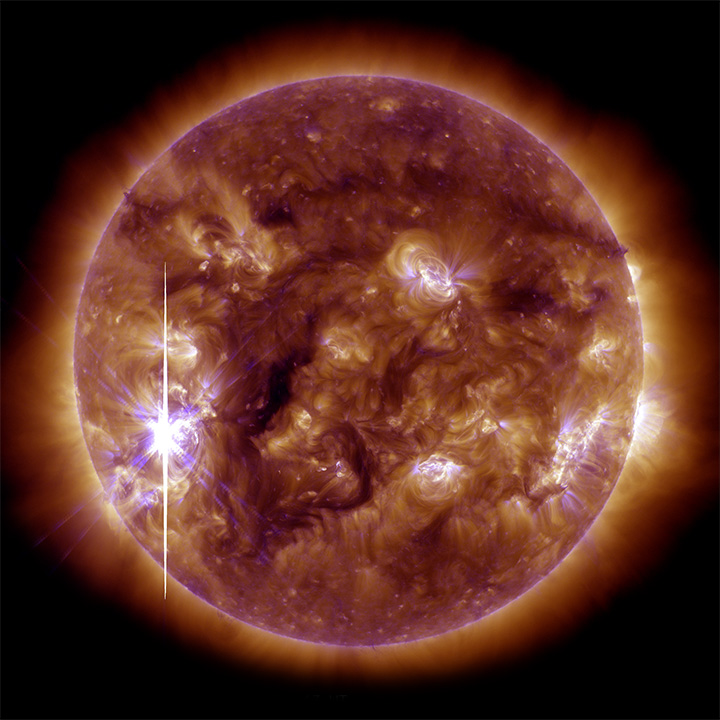NASA: The Sun Flares Up - 11.13.13
Posted by Ricardo Marcenaro | Posted in NASA: The Sun Flares Up - 11.13.13 | Posted on 12:47
On November 5, 2013, the Sun
brightened when an X-class solar flare—the largest so far this
year—burst from a large, active sunspot. The flare followed a series of
more than a two dozen flares
that have occurred since October 21, though the November 5 flare
originated in a different active region. The event was classified an
X3.3 flare, falling into the category of most intense explosions.
This view of the flare comes from NASA’s Solar Dynamics Observatory (SDO), and it shows the Sun in extreme ultraviolet light (blending 193 and 131 angstrom observations). The long streak of light is likely due to solar protons saturating the imager.
The unusual color is due to the blending of false colors that are
assigned to each wavelength by solar physicists to distinguish the
different bands. The image is from 5:12 p.m. Eastern Standard Time
(22:12 UTC), the peak of the short flare.
A solar flare is a burst of light and radiation from the Sun’s
magnetic atmosphere. The energy travels at the speed of light to reach
Earth just eight minutes after the flare; at Earth, a part of the
atmosphere called the ionosphere absorbs it. Normally, that’s the end of
the story, but this flare was unusual. It had a very quick rise and a
very quick decay, says Alex Young, associate director for science in the
heliophysics division of NASA Goddard Space Flight Center. The burst of
energy triggered electric currents in the ionosphere, which in turn
generated a magnetic field. TThe quick burst of energy caused a surge of
electric currents in the ionosphere. All electric currents generate
magnetic fields, and the fast surge caused by the flare creates a
magnetic field strong enough to be measured from the ground. This rare
bump in the magnetic field from a solar flare is called a magnetic crochet.
Since solar flares heat and distort the ionosphere, they can
interfere with radio communication. The NOAA Space Weather Prediction
Center warned
of a potential blackout of shortwave radio communication for about an
hour after the November 5 flare. This type of communication is often
used for long-range aviation, amateur radio, and emergency
communication. Beyond radio interference, the flare did not affect
Earth.
The eruption that produced this flare also sent out a coronal mass
ejection (CME), which is a mass of charged particles and magnetic field
energy that bursts from the Sun like a volcanic eruption. Material from a
coronal mass ejection takes two to three days to reach Earth, but in
this case, the coronal mass ejection is going to miss Earth. Coronal
mass ejections interact with Earth’s magnetic field to generate auroras
and magnetic storms.
The recent burst of solar activity is part of a natural 11-year cycle
that may be nearing its peak, says Young. It comes after an extended
quiet period, with the last significant flares in May. While the
November 5 flare isn’t significant on its own, each flare is valuable to
scientists trying to understand the Sun. “Every flare is different,”
says Young. “They are complicated because so much is going on. Because
of that, each flare gives us more insight into what is happening. The
more flares we see, the more we can sample the different variations.”
References
- Australian Government Radio and Space Weather Services (2013, November 6) A solar flare effect. Accessed November 6, 2013.
- NASA (2013, November 6) Sun sends out a significant solar flare. Accessed November 6, 2013.
- NASA (2013, October 31) Something flare-y this way comes: The mini-Halloween storms of 2013. Accessed November 6, 2013.
- NASA Solar Dynamics Observatory (2013) Dynamic active region up close. Accessed November 6, 2013.
- NOAA Space Weather Prediction Center (2013, November 6) Alerts issued in November. Accessed November 6, 2013.
- NOAA Space Weather Prediction Center (2013, November 4) Space weather highlights. Accessed November 6, 2013.
- NOAA Space Weather Predication Center (2013, October 28) Space weather highlights. Accessed November 6, 2013.
- NOAA Space Weather Prediction Center (2013, November 6) Top news of the day. Accessed November 6, 2013.
- Young, Alex (2013, November 6) The X3.3 solar flare from ARI 1890 produced a rare event, a Magnetic Crochet. Accessed November 6, 2013.
NASA image by Scott
Wiessinger, Solar Dynamics Observatory at NASA Goddard Space Flight
Center. Caption by Holli Riebeek.
- Instrument:
- SDO
NASA: The Sun Flares Up - 11.13.13
Ricardo M Marcenaro - Facebook
Blogs in operation of The Solitary Dog:
Solitary Dog Sculptor:
http://byricardomarcenaro.blogspot.com
Solitary Dog Sculptor I:
http://byricardomarcenaroi.blogspot.com
Para:
comunicarse conmigo,
enviar materiales para publicar,
propuestas comerciales:
marcenaroescultor@gmail.com
For:
contact me,
submit materials for publication,
commercial proposals:
marcenaroescultor@gmail.com
My blogs are an open house to all cultures, religions and countries. Be a follower if you like it, with this action you are building a new culture of tolerance, open mind and heart for peace, love and human respect.
Thanks :)
Mis blogs son una casa abierta a todas las culturas, religiones y países. Se un seguidor si quieres, con esta acción usted está construyendo una nueva cultura de la tolerancia, la mente y el corazón abiertos para la paz, el amor y el respeto humano.
Gracias :)



Comments (0)
Publicar un comentario